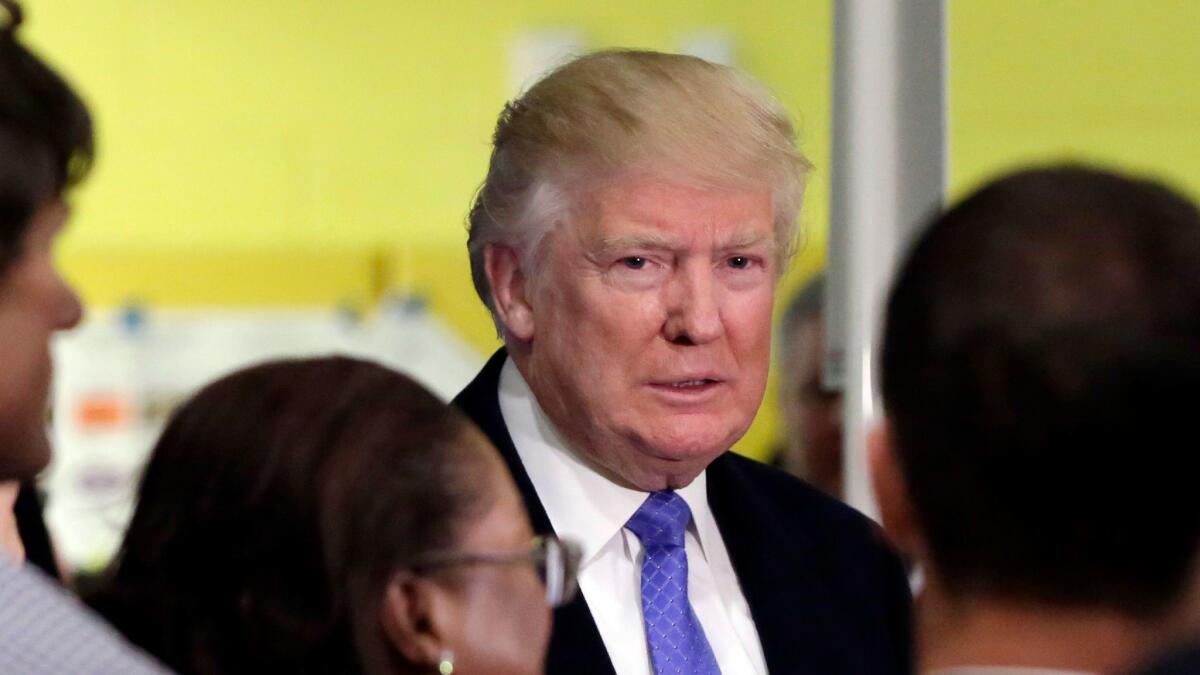Op-Ed: Why did Trump win? The economy, stupid

Pundits and political scientists will be trying to explain Donald Trump’s upset victory for weeks, maybe months. Why were the polls predicting a Hillary Clinton landslide so wrong? Didn’t she win the debates? Was it the emails that buried Clinton? Was the trust factor the decisive factor? Did FBI Director James Comey cast the deciding vote? Did the pundits underestimate the ferocity of anti-immigration sentiment? Or the widespread yearning for sweeping Washington clean of all those corrupt and self-dealing politicians — the real change that Trump repeatedly promised?
Economists aren’t suffering from this post-election confusion. They are in the enviable position of saying “I told you so.” Not necessarily because they wanted Trump to win — or even voted for him — but because they base their predictions on economic variables. And those variables were indicating a Trump victory long before the first ballots were cast.
The basic premise of economic modeling for election outcomes is that people vote their pocketbooks. Or, as Bill Clinton put it: “It’s the economy, stupid” (which may not sound terribly reassuring to his wife). If the economy has been good, people don’t seek out change; they are content with the party in power. On the other hand, if the economy isn’t delivering the growth and jobs that people expect, they want a change in leadership — a different party in the White House.
Unfortunately for Clinton, the Obama administration was able to deliver only six quarters of good news out of the 31 that it has presided over.
From this perspective, it doesn’t really matter who the candidate of either party is — much less their gaffes or their crude language or their bankruptcies or their reputed dealings with Vladimir Putin’s Russia. All that matters is whether voters want a change or not. And that depends on how well the economy has been performing under the outgoing administration; in this case, the Obama administration.
For the last, agonizing six months, the airwaves and newspapers have been filled with political prognoses. Every commentator claimed special insight into how voters would cast their ballots and why. Most of them were wrong, of course. And according to economic theory, completely irrelevant. None of the political factors the pundits cited ad nauseum even enter the best economic models.
The most famous model was constructed by Yale economist Ray Fair, who argues that people’s sense of how well the economy is performing depends on two key variables: GDP growth and inflation.
If GDP growth is robust, job creation will keep up with the population and workers will be happy. If inflation is restrained, consumers will be happy. So a combination of robust growth and restrained inflation will make voters feel happy about the economy. Happy voters will vote for the incumbent party — and vice versa.
Simply put, Clinton lost because the economy under President Obama did not perform well enough to meet Fair’s thresholds of happiness. Economic growth was anemic for nearly all of the last eight years. As a result, job creation lagged far behind the records set during other post-recession recoveries.
In the Fair model, GDP growth in the three calendar quarters prior to the election is critical: That’s when voters are especially attuned to how the economy is performing. And on that count, Clinton lost a lot of votes; GDP growth was a paltry 0.8 % in the first quarter of this year, 1.4 % in the second and 2.9 % in the third. This sluggish growth hardly inspired confidence in the economic policies of an Obama/Clinton team, and it seems Clinton couldn’t talk her way out of this performance.
The Fair model, furthermore, says that “good news” quarters are particularly important to the incumbent party. Every calendar quarter in which GDP growth exceeds the long-term average of 3.2% yields a popular vote advantage of .873 %. That’s significant in presidential elections that are typically won by only a few percentage points. Unfortunately for Clinton, the Obama administration was able to deliver only six quarters of good news out of the 31 that it has presided over. A couple of more robust growth quarters could have swung the election to the Democrats.
The inflation record was benign. Every percentage point of inflation over the preceding 15 calendar quarters is a negative for the incumbent party. Except for a brief spike in 2011, the inflation rate has stayed well below the Federal Reserve’s target of 2%. So voters didn’t turn away from Clinton because of rising prices. It was only GDP growth that did her in.
Fair predicted a Republican victory back in May in this very newspaper. All he needed were a few, readily available statistics on the economy’s performance over the past four years.
Needless to say, Fair’s model has been more accurate than any political prognosticating, an irony that will drive political scientists and pundits crazy. The same people who got the election all wrong will spend the next few months spinning away their failures. But the truth is simple: The state of the economy was Trump’s ace in the hole.
Brad Schiller is an emeritus professor of economics at American University and author of “The Economy Today.”
Follow the Opinion section on Twitter @latimesopinion or Facebook
More to Read
A cure for the common opinion
Get thought-provoking perspectives with our weekly newsletter.
You may occasionally receive promotional content from the Los Angeles Times.










